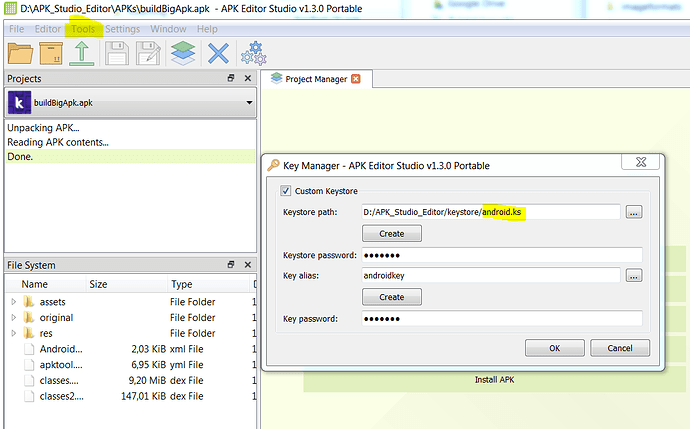
- #KEYSTORE EXPLORER MAKE JKS INSTALL#
- #KEYSTORE EXPLORER MAKE JKS SERIAL#
- #KEYSTORE EXPLORER MAKE JKS FULL#
- #KEYSTORE EXPLORER MAKE JKS SOFTWARE#
- #KEYSTORE EXPLORER MAKE JKS PASSWORD#
#KEYSTORE EXPLORER MAKE JKS PASSWORD#
This password will be required for other steps, keep it handy. We suggest using a complex password with 8 characters. You will be prompted to enter an Alias name. Once you have completed your entry hit OK.Please note that the CN field should be the Domain you are trying to secure. This information will be needed to Generate the CSR. At the bottom of the window edit the Name section.Use the RSA Algorithm with 2048 key size.Right-click in the white space and select Generate Key Pair (Ctrl+G).Run the application and select Create A New Keystore and select the JKS radial.Append Signed SSL Certificate to Keystore.

Here are quick links to sections within the article: Our document was written and tested with Certificates purchased from Thawte or Digicert. The steps below will help you create a Java Keystore (JKS) which contains a Self-Signed SSL Certificate or one that has been purchased from a Certificate Authority. Protect this file with your life.This article will walk you through the different steps in creating and installing an SSL certificate on a Tomcat Webserver in a Windows Environment. There is a great app on windows you can use to open these (Not strictly necessary for now!). This will get your Keystore from Expo, the Keystore is a container which holds your signing keys. If you're just looking for a gui, I recommend you to take a look at Keystore Explorer. Used it years ago and it could handle basically any common format and makes converting between them very easily. Keystore Explorer can handle probably all of that except SSH, though it is a GUI and I don't know if it has CLI support.Īs an alternative to leaning openssl command line check out Keystore Explorer. To me openssl and similar packages to it feel like comparing the UX of tar vs docker CLIs, where the former is nigh unusable, as humorously explained here: In comparison, have a look.
#KEYSTORE EXPLORER MAKE JKS FULL#
You know, I feel like more people wouldn't have a problem with actually doing this if it weren't so challenging and full of sometimes unpleasant CLI commands. > Several comments here mention running your own CA. Should you use Let's Encrypt for internal hostnames?
#KEYSTORE EXPLORER MAKE JKS INSTALL#
If you intent to do more with certificates: download and install KeyStore Explorer. I have used in multiple occasions when standard tools couldn't do the task.Ĭreating a self-signed cert for HomeBridge on macOS This tool supports most common certificate and wallet files.
#KEYSTORE EXPLORER MAKE JKS SERIAL#
Orakpi wallet: Work with a cert with a short serial
#KEYSTORE EXPLORER MAKE JKS SOFTWARE#
But rather the fact that all of the complexity the software has is laid bare, so that nobody could mistakenly assume. Kind of like it? Not the fact that using such a GUI would be almost impossible, like the humorous example of an "engineer oriented UI" in the Silicon Valley series which might be confusing for most people. Then let me tell you about keystore explorer which will make your life a lot easier (and less chance that there are more then 1 keys inside your keystore. Įxport root + intermediate + CA Certificate Personally, I've also had decent experiences with Keystore Explorer: I actually wrote about using it on my blog, which has plenty of screenshots. Mkcert: Simple zero-config tool to make locally trusted development certificates I'm guessing since you are using a Java app you should either have a JKS (old fashioned) or a P12 (pkcs12) keystore, one of those should contain the private key, you can use keystore explorer to extract the data. Yes, that's clear but you need the private key to create a CSR.

They can help you see what people think about KeyStore Explorer and what they use it for. We have tracked the following product recommendations or mentions on Reddit and HackerNews.


 0 kommentar(er)
0 kommentar(er)
